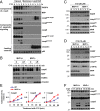Immunoediting role for major vault protein in apoptotic signaling induced by bacterial N-acyl homoserine lactones
- PMID: 33723037
- PMCID: PMC8000436
- DOI: 10.1073/pnas.2012529118
Immunoediting role for major vault protein in apoptotic signaling induced by bacterial N-acyl homoserine lactones
Abstract
The major vault protein (MVP) mediates diverse cellular responses, including cancer cell resistance to chemotherapy and protection against inflammatory responses to Pseudomonas aeruginosa Here, we report the use of photoactive probes to identify MVP as a target of the N-(3-oxo-dodecanoyl) homoserine lactone (C12), a quorum sensing signal of certain proteobacteria including P. aeruginosa. A treatment of normal and cancer cells with C12 or other N-acyl homoserine lactones (AHLs) results in rapid translocation of MVP into lipid raft (LR) membrane fractions. Like AHLs, inflammatory stimuli also induce LR-localization of MVP, but the C12 stimulation reprograms (functionalizes) bioactivity of the plasma membrane by recruiting death receptors, their apoptotic adaptors, and caspase-8 into LR. These functionalized membranes control AHL-induced signaling processes, in that MVP adjusts the protein kinase p38 pathway to attenuate programmed cell death. Since MVP is the structural core of large particles termed vaults, our findings suggest a mechanism in which MVP vaults act as sentinels that fine-tune inflammation-activated processes such as apoptotic signaling mediated by immunosurveillance cytokines including tumor necrosis factor-related apoptosis inducing ligand (TRAIL).
Keywords: bacterial signaling; cross-kingdom communication; immunoediting; immunosurveillance.
Copyright © 2021 the Author(s). Published by PNAS.
Conflict of interest statement
The authors declare no competing interest.
Figures





References
-
- Smyth M. J., Godfrey D. I., Trapani J. A., A fresh look at tumor immunosurveillance and immunotherapy. Nat. Immunol. 2, 293–299 (2001). - PubMed
-
- Dunn G. P., Old L. J., Schreiber R. D., The immunobiology of cancer immunosurveillance and immunoediting. Immunity 21, 137–148 (2004). - PubMed
-
- Ben-Neriah Y., Karin M., Inflammation meets cancer, with NF-κB as the matchmaker. Nat. Immunol. 12, 715–723 (2011). - PubMed
-
- Moore R. J., et al. ., Mice deficient in tumor necrosis factor-alpha are resistant to skin carcinogenesis. Nat. Med. 5, 828–831 (1999). - PubMed
-
- Wilson J., Balkwill F., The role of cytokines in the epithelial cancer microenvironment. Semin. Cancer Biol. 12, 113–120 (2002). - PubMed
Publication types
MeSH terms
Substances
LinkOut - more resources
Full Text Sources
Other Literature Sources
Miscellaneous

